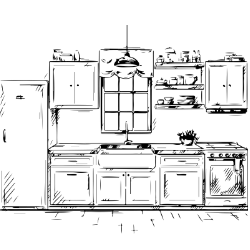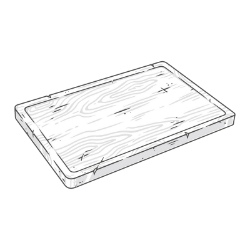
How to Build a Cabinet for a Farmhouse Sink in Easy to Follow Steps [2023]

Want to customize your own cabinet? Trying to cut down on costs and would opt to build your own? Can't find a ready-made set that would fit your farmhouse sink, your kitchen, and your preference?
Whatever your reason is, this article will walk you through DIY-ing your cabinet project step by step.
How to Build a Cabinet for a Farmhouse Sink
Farmhouse sink, or also commonly known as “apron front sink”, is a type of drop-in sink which has its front-facing side exposed. Contrary to common steel sinks which are installed inside the countertops, farmhouse sinks are built in the cabinet.
This means that the kitchen counter is cut out to surround the sides of the farmhouse sink, letting the front-facing side blend in with the whole counter. This type of sink often comes in porcelain, stainless steel, or fireclay and can weigh 100-200 pounds depending on the material.
Whether the apron front sink is for the laundry room, bathroom, or any area in your house, it needs a well-designed sink cabinet. It should not only look good on the outside; the structure of the cabinet should be able to support the farmhouse sink as well.
Luckily, you don’t need rocket science to do a small kitchen remodel or bathroom upgrade such as this. Here are the basic tools and supplies necessary to build a sink base cabinet.
Tools and Supplies You’ll Need
In addition to your farmhouse sink and faucet, here are the supplies and equipment you’ll need to prepare when building a sink base cabinet from scratch:
- Measuring tape
- Clamps
- Circular saw with guide track
- Drill
- Impact Drive
- Pocket hole jig
- Jig saw
- Squares
- 1 1/4″ pocket hole screws or wood/melamine glue
Wood products:
- Side pieces and base: 3/4″ plywood
- Back panel: 1/4″ plywood
- Face frame and doors: 1x2 boards
- Inset panel: 1/2" sande plywood
- Bottom piece and sink support piece: 2×4 boards
- Toe kick base: 2×4 boards (optional)
Measure the Sink
First thing you need when building a base cabinet is the sink. One might end up doing more adjustments and changes to the kitchen counter if you buy this last.
It's important to point out that most apron front sinks do not have perfectly straight sides. Some have rounded edges. Some even have a narrow bottom and a wide top. The sink measurements are usually found online or in-store. The ones found in manuals are usually rounded up.
If these numbers are not available, take a measuring tape and measure the sides of your sink.
Take note of the measurements as accurately as possible. We recommend noting down to the 1/16”. If the edge strides in between two lines, adjust it a bit and go for the bigger measurement. If you round it down, chances are it may not fit once you start the installation process.

For the height, measure the full length from the very top of the sink to the bottom of the sink base.
For the cabinet width, you need the measurement from one side to the other. Make sure to check the edges of the top lid width and those of the bottom width. These measurements would help indicate if it is irregularly shaped.
For depth, this can be measured from the front side to the back. This is important for cabinet depth but it won’t change the shape or look of the cabinet design.
Build the Base
Now that you have the measurements, you’re ready to begin building the sink base cabinet.
Build your base by taking your 2x4s. After cutting these according to needed length and width, you can hold them in place with the use of screws.
The back panel (the one placed against the wall) is optional. Typically, a 1/4 wood is used for this. Some might opt to leave it out to skip cutting out plumbing holes during installation. However, if you omit the back piece, make sure that the wall is painted.
Water spills or splashes may happen anytime. To avoid damaging the drywall, there should be a protective layer - either paint or wood.
Offset the Base
When you have your base, cut the 3/4" plywood.
Place this on top of the base and attach it by screwing it in. This plywood will provide the usual toe kick allowance of 2-3 1/2 inches, which is why it will be offset from the base.
Take note, however, if you have existing cabinets in the room with less or more toe kick allowance, make sure to adjust the base accordingly. The new cabinet should match the toe kick measurements of the other existing cabinets.
Construct Sink Support
At this point, you can now construct the supports for the sink. Install a piece of 2x4 vertically in each corner. These will serve as legs that will support the weight of the sink.
These support frames would also determine the height of your sink.
To test the height, place the sink on top, but DO NOT leave it on for too long! Check if the front support has the correct height. Make adjustments if necessary. If everything is according to plan, proceed to the next step.
Do the Trimming
Get your 1x3 to trim out the topmost part - top of the base cabinet.
You can use 1x2 for the sides, and a 1x4 for the bottom part. Make sure that the trim pieces are level before gluing or fixing them in. This might compromise the sturdiness of your structure.
Moreover, uneven trims would not leave a gap between your sink but would also make it difficult to attach the cabinet doors or face frames.
Now, you have the frame of a sink base cabinet! The next thing would just be adding the finishing on the front of the cabinet - face frames, paint, doors (optional).
Face frames are usually 1 1/2" thick or wider. To do the face frame, grab the rails and stiles and cut them according to your planned design. At the end of each rail, make holes set for 3/4” material.
One rail is attached at the bottom of the stiles (connected on their edges) while the other is placed parallel to the height of the sink.

You can use wood glue and the 1 1/4" pocket hole screws to pin them down. Let it sit and dry. You can use a clamp to help you in this process.
Before attaching it to the sink base cabinet, check if the face frame follows the shape of your sink. Measure and mark the points to the face frame. Cut and adjust the face frame, if needed.
Using wood glue, you can now attach the face frame to the front of the cabinet.
Make sure the top rail meets with the top of the cabinet. The same is true with the bottom side.
Apply the glue to the front and use the pocket holes in the base cabinet and sides to hold it in place, and you're done!
You can opt to paint the face frame according to the motif or design of the room. For more ideas, you can also check this tutorial on how to create false front doors [1]!
Optional: Install the Farmhouse Sink
After the final touches are made, now it’s time to install the sink!
Manuals are usually included and these tell you how to connect the water pipes and drain. Once the installation is complete, you can finally put the countertop.
That’s it! You now have your own farmhouse cabinet.
Kinds of Farmhouse Sink Cabinets
There are basically two kinds of kitchen cabinets you can choose from: frameless cabinets and face frame cabinets.
Frameless cabinets, also referred to as "European style cabinets," do not have borders on the edges. This would work for an apron front sink with straight front faces.
However, if it is irregularly shaped, a face frame would work better and give it more structure.
The face frame would help you fill the gaps where the sides or edges are curved.
Moreover, it will follow the mold of the sink. Plus, if you plan to install doors to the kitchen cabinet, installing a face frame would be required.
Frequently Asked Questions
Do You Need A Special Cabinet For A Farmhouse Sink?
No. There are no specific base cabinets necessary for farmhouse sinks.
Although there are ready-made options, creating a sink base cabinet from scratch is not that hard to accomplish.
The only important thing to remember is that these are much heavier than your average ones. Thus, aside from the design, your cabinet should be sturdy too.
Can You Put A Farmhouse Sink in A Regular Cabinet?
Sure you can! Just make sure that it fits the measurement and can support the sink you plan to install. You can easily remodel your existing cabinet if you plan to buy one.
What Size Cabinet Do You Need For a 36 Inch Apron Sink?
If the sink width measures 36”, we recommend having a sink base cabinet that measures at least 39”.
Since the sink is going in the kitchen counter, the cabinet below it should be bigger than the sink by a few inches both for function and aesthetic purposes.
How do you cut a farmhouse sink for cabinets?
One common mistake people make is they buy or build a cabinet then look for a sink. If you are planning to install a farmhouse sink in a room at home, this should be the first step because everything will adjust according to the sink.
Cutting the sink cabinet (installed or made from scratch) is fairly easy.
Either way, we recommend using a circular saw to get the job done. It produces cleaner wood cuts compared to a hand saw and of course, it's much easier and faster.
Conclusion
Ta-da! There you have it.
Whether this was a bit of a kitchen remodel, laundry room upgrade, or if you were in the process of having your own place built, we hope this tutorial helped you in creating your own cabinet.
Share your cabinet story in the comments section below!





